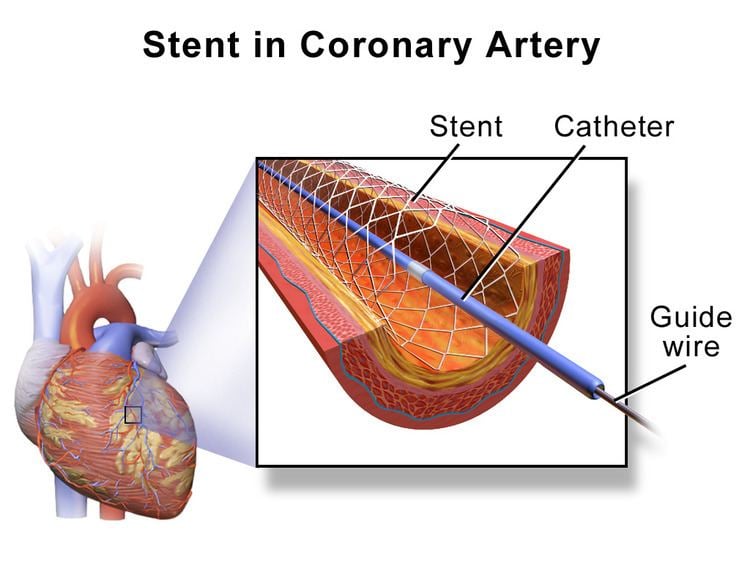MeSH D015607 | MedlinePlus 002303 | |
 | ||
In medicine, a stent is a metal or plastic tube inserted into the lumen of an anatomic vessel or duct to keep the passageway open, and stenting is the placement of a stent. There is a wide variety of stents used for different purposes, from expandable coronary, vascular and biliary stents, to simple plastic stents used to allow the flow of urine between kidney and bladder. Stent is also used as a verb to describe the placement of such a device, particularly when a disease such as atherosclerosis has pathologically narrowed a structure such as an artery.
Contents
A stent should be differentiated from a shunt. A shunt is a tube that connects two previously unconnected parts of the body to allow fluid to flow between them. Stents and shunts can be made of similar materials, but perform two different tasks.
Etymology
As Ariel Roguin describes in his paper "Stent: The Man and Word Behind the Coronary Metal Prosthesis", the current acceptable origin of the word stent is that it derives from the name of a dentist. Charles Thomas Stent, notable for his advances in the field of denture-making. He was born in Brighton, England, on October 17, 1807. He was a dentist in London and is most famous for improving and modifying the denture base of the gutta-percha, creating the Stent's compounding that made it practical as a material for dental impressions.
The verb form "stenting" was used for centuries to describe the process of stiffening garments (a usage long obsolete, per the Oxford English Dictionary) and some believe this to be the origin. According to the Merriam Webster Third New International Dictionary, the noun evolved from the Middle English verb stenten, shortened from extenten, meaning to stretch, which in turn came from Latin extentus, past participle of extendere, to stretch out. Others attribute the noun "stent" to Jan F. Esser, a Dutch plastic surgeon who in 1916 used the word to describe a dental impression compound invented in 1856 by the English dentist Charles Stent (1807–1885), whom Esser employed to craft a form for facial reconstruction. The full account is described in the Journal of the History of Dentistry. According to the author, from the use of Stent's compound as a support for facial tissues evolved the use of a stent to hold open various bodily structures.
The first (self expanding) "stents" used in medical practice in 1986 by Ulrich Sigwart in Lausanne were initially called "Wallstents" after its inventor Hans Wallsten. Julio Palmaz et al. created a balloon expandable stent that is currently used.
History
The first use of a coronary stent is typically attributed to Jacques Puel and Ulrich Sigwart when they implanted a stent into a patient in Toulouse, France in 1986. It was used as a scaffold to prevent the vessel from closing and to avoid restenosis in coronary surgery—a condition where scar tissue grows within the stent and interferes with vascular flow. Shortly thereafter in 1987, Julio Palmaz (known for patenting a balloon-expandable stent) and Richard Schatz implanted their similar stent into a patient in Germany. The use of these bare-metal stents helped reduce the incidence of restenosis from 30–40% in coronary surgery to 20–30%.
Though many doctors have created the stent, the first FDA approved stent was invented by Cesare Gianturco and Gary S. Roubin.
To further reduce the incidence of restenosis, drug-eluting stents (DES) were introduced which consisted of stents coated in anti proliferative agents. Animal studies and later clinical trials showed a reduction in restenosis to approximately 5%.
